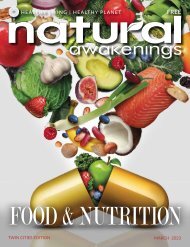Natural Awakenings Twin Cities November 2019
Natural Awakenings Twin Cities magazine is your source for healthy living, healthy planet information. Have you visited our website lately? Sign up for our Newsletter and Digital Magazine, read archived articles from local experts, and keep up with local healthy living events. Visit NATwinCities.com today. We provide a complete toolkit for businesses. List your healthy or green business for free. Enter your calendar events for free.
Natural Awakenings Twin Cities magazine is your source for healthy living, healthy planet information. Have you visited our website lately? Sign up for our Newsletter and Digital Magazine, read archived articles from local experts, and keep up with local healthy living events. Visit NATwinCities.com today.
We provide a complete toolkit for businesses. List your healthy or green business for free. Enter your calendar events for free.
Create successful ePaper yourself
Turn your PDF publications into a flip-book with our unique Google optimized e-Paper software.
photo by by Samuel Joubert<br />
says Bays, adding that research shows ceremonies<br />
and moments of reflection lead<br />
to more mindful, healthy eating.<br />
“Instead of talking on the phone, try<br />
cooking in silence. Drawing your awareness<br />
to details like the smell of basil, the<br />
color of tomato and the touch of the spoon<br />
brings so much richness to the act of<br />
cooking,” says Bays.<br />
Such a focus leads to a sense of appreciation<br />
for the ingredients of meals<br />
and life, says Myoju Erin Merk, a priest at<br />
the San Francisco Zen Center. “Making a<br />
meal is an active extension of our ‘sitting’<br />
(meditation) practice.”<br />
Connect with Washington, D.C. freelance<br />
writer April Thompson at AprilWrites.com.<br />
The Zen of Food<br />
Here are a few simple tips from Buddhist<br />
priests and cooks on making<br />
mealtime more mindful.<br />
Have a mid-meal gut check, suggests<br />
Jan Chozen Bays. “When your stomach<br />
feels three-quarters full, have a conversation<br />
with a friend or have something to<br />
drink before continuing to eat. Often you<br />
will find after 20 minutes you are actually<br />
full,” says the author and priest.<br />
Myoju Erin Merk, a priest at the San<br />
Francisco Zen Center, suggests setting a<br />
phone timer in the kitchen to mark it as a<br />
practice time to tune into the senses. “Try<br />
to slow down and notice what’s happening<br />
as you cook. Try to stay with the sensory<br />
experience and not judge everything, like<br />
whether the carrot is cut right. It can be a<br />
very relaxing and peaceful way to work in<br />
the kitchen.”<br />
Make the first few sips or bites of<br />
a meal mindful, spending the first few<br />
moments in silence if possible, says Bays.<br />
“Working quietly with that pile of carrots<br />
or onions, you have space to focus on just<br />
one task,” adds Merk.<br />
Incorporating all of the five tastes<br />
of Buddhism—salty, sweet, sour, bitter and<br />
umami (savory)—is another way to bring<br />
meals in balance, according to author and<br />
priest Gesshin Claire Greenwood. “Having<br />
all of these flavors represented makes a<br />
meal feel balanced and satisfying.”<br />
Buddha Bowl<br />
Cookbook author Jean-Phillippe Cyr says,<br />
“I love bowl recipes: they’re generous and<br />
colorful, and they let us get creative. Layer<br />
grains or cereals, vegetables, legumes and<br />
dressing, and voilà! That’s all there is to it.”<br />
Pumpkin seeds are an incredible<br />
source of protein, and tahini contains more<br />
protein than milk. Healthy cooks will be<br />
sure to keep this tahini dressing recipe<br />
close, because they can use it in everything.<br />
Yields: one bowl<br />
Cooking Like a Zen Master<br />
1 sweet potato, peeled and diced<br />
2 dried figs, sliced<br />
2 Tbsp olive oil<br />
Salt, to taste<br />
1½ cups cooked quinoa<br />
¼ cup frozen shelled edamame, cooked<br />
For the dressing:<br />
1 (¾-inch) piece fresh ginger, minced<br />
1 clove garlic, minced<br />
Pinch of sea salt<br />
2 Tbsp tahini<br />
1 Tbsp soy sauce<br />
1 Tbsp lemon juice<br />
1 Tbsp maple syrup<br />
1 Tbsp olive oil<br />
Garnish:<br />
Pumpkin seeds<br />
Microgreens<br />
Preheat the oven to 350° F. Place the sweet<br />
potato and figs in a baking dish.<br />
Drizzle with oil, then season with salt and<br />
bake for 30 minutes.<br />
Place the ginger, garlic and salt in a mortar<br />
(preferred) or blender, then mash the<br />
ingredients together.<br />
Transfer to a bowl and add the tahini, soy<br />
sauce, lemon juice, maple syrup and oil.<br />
Stir to combine.<br />
Place the sweet potatoes and figs in a large<br />
serving bowl. Add the quinoa and edamame.<br />
Drizzle with the dressing and garnish.<br />
Serve immediately.<br />
Tip: For those that can’t digest raw garlic,<br />
don’t use it, or cook it before adding it to<br />
the dressing.<br />
Excerpted with permission from The Buddhist Chef, by Jean-Phillippe Cyr.<br />
Gratitude can transform common days into<br />
thanksgivings, turn routine jobs into joy, and change<br />
ordinary opportunities into blessings.<br />
~William Arthur Ward<br />
<strong>November</strong> <strong>2019</strong><br />
23

















